
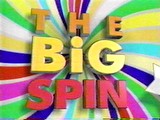
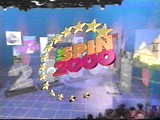
THE BIG SPIN



The Big Spin, Califorinia's state lottery show, has been on for over 13 years. Here are the rules to most of the games that have been played during the show's run.
The Big Wheel (played throughout) | ||
| The mainstay game of the show. A lottery winner has the opportunity to spin a large wheel, which contains a series of pegs lined around the edge, the valleys they create being marked with dollar values ranging from $20,000 to $1 Million. A ping-pong ball encased inside the wheel bounces off of the pegs, eventually settling into one of the valleys. Whichever valley the ball settles into is the amount that the person wins. The wheel must make three complete revolutions for the spin to be valid, and the ball must be at rest for 5 seconds for the result to be official. | 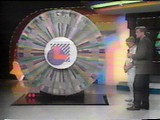
| |
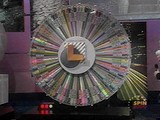
| From the beginning of the show, some valleys were marked "DOUBLE". If a ball landed in one of these valleys, the player got to spin the wheel again, and won twice the value of the space the ball settles in. In 1996, several "DECISION" spaces were added, which offered a player $50,000 to stop or another spin of the wheel, at the risk of landing on a smaller amount. In 1999, the "DOUBLE" and "DECISION" valleys were removes in favor of "TRIPLE" spaces, which earned a second spin at triple value. | |
The Winner's Circle (played 1996-9) | ||
| Ten lottery players took part in a small game. The winner got to spin the big wheel, the other 9 players took home $1,500. Each player stood around a circular maze, where a motorized ball (endearingly named "Scooter") would be placed into the center. Scooter would wander around the maze until it fell into a trough in front of one of the players. The player in front of that trough wins the spin of the wheel. | 
| |
California Countdown/California Gold (played 1999-) | ||
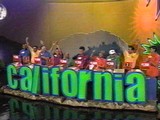
| Accompanied with a short-term set change, ten lottery players participated in this replacement to the Winner's Circle. In its original version, each player stood behind a letter in the name "California". After a countdown of 3, they would each press a button causing a sign to pop out of their letter, showing the amount they won (between $1750 and $2500) or a number from 1 to 3, signifying the order of play in the next round. | |
| In the second round, each player selected a section of a map of California. After the players took their picks, the map would light up. One section would win $4000 for the player who chose it, another won $5000, and a third one a spin of the wheel. (Occasionally, the map of California would be replaced with three surfboards.) | 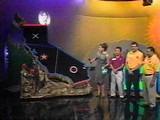
| |
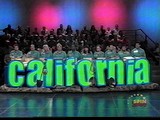
| When "The Big Spin" became "Big Spin 2000", several changes were made. First, in the beginning, the players would reveal their signs one at a time. 2 players went on to the next round. In the second round, the players were given a bin to hold gold dust (originally) or gold nuggets (currently). Each player took a pick from nine bins, each having from 1 to 9 ounces/nuggets of gold. The leader after one round could continue trying to build his/her score or stop and make the other player beat his/her total. The player who came closest to 10 ounces/nuggets without going over won a spin of the wheel, the other player left with $5000. | 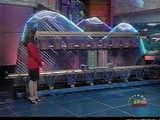
|
The Fantasy 5 Dream Machine (played 1996-) | ||

| A lottery player stood in front of a large pachinko machine. The player hit a button, sending a ball into the machine, with slots worth (from left to right) $30,000, $10,000, $40,000, $25,000, and $20,000. The player won the value of the slot the ball landed in. If a second ball landed in the same slot, however, the amount was negated. The player could stop after each drop; a maximum of 5 balls were played. If someone managed to get one ball in each slot, a bonus $25,000 was awarded, for a total of $150,000. | |
Monopoly (played 1996) | ||
| One lottery winner played in this adaptation of the board game. Starting at GO, the player began by choosing to move forward either 2 or 7 spaces, which takes him/her to either Community Chest or Chance, sending the player to yet another space on the board. Each property conceals either an amount of money from $4000 to $7000, or a Top Hat. If a Top Hat is revealed, the player can either cash it in for $10,000 or keep it, in an attempt to find a second one. The player also places hotels on two properties which adds an extra $7500 if he/she lands on that property. Landing on Go to Jail, Income Tax or Luxury Tax takes money away; passing GO earns $200. Getting two Top Hats wins the top prize, $50,000. | 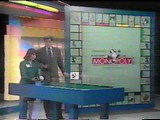
| |
Dream Home played (1996)Three players begin the game. Each player chooses a key, which opens one of three doors. Behind each door is either $1000, $2000, or a large key, which means the player wins a chance at the grand prize. In the second round, the player chooses three keys out of 18 available. 16 keys win an amount of money associated with one room of the home (from the $15,000 kitchen to the $40,000 garage), 2 keys for each of eight rooms. One key opened the booby prize - the $8000 closet - and one opened the grand prize: a $180,000 dream home. After each key is used, the player can choose to take the room they won or give it up for the next key. | ||
Wizard of Odds (played 1996-7) | ||
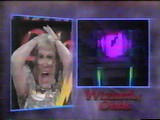
| Three players took part. Each player took turns hitting a button, which sent a ball up from a hopper containing 100 balls. Most balls had a dollar amount from $1000 to $6000, which was added to the player's score. Other balls won bonus turns, took money away, or disqualified a player immediately. Some balls had a lightning bolt on them; if one of them was drawn, the player could cash it in for $10,000 or hold on to it in the hopes of drawing a second lightning bolt. If successful, the player won the maximum prize of $50,000 and the game ended for everybody. Otherwise, each player got 5 turns. The minimum a player could win was $4000. | 
|
Fame and Fortune (Played 1998-9) | ||
| Three players started. In the original version, each player chose a letter from a board of 16, each number having a number from 1 to 16. The two players with the highest numbers advanced to the next round; the third place player left with $5000. In the second round, the board had 9 numbers, each concealing an amount of money from $7000 to $13,000. The player who chose the higher amount advanced to the third round, the loser took home the amount he/she picked. | 
| |
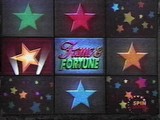
| In the third round, the player chose one of four stars. Three concealed amounts of money which were added to the player's total, while one hid another star behind it, which won the top prize, $75,000. During "Big Spin 2000", a couple changes were made: Only the player got to see the number/money amount chosen. After everyone picked, the player secretly decided to keep their picks or make another choice from the board. | |
Fun in the Sun (played 1998) | ||
| Four players played. Each player chose one of four keys. One key unlocked the door to a 1998 Ford Mustang. After all the keys were chosen, the players tried to unlock the door, one by one. The player that unlocked the car won it, along with $12,500 for taxes and licensing fees. The others left with $2500. | 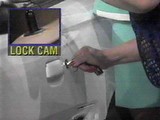
| |
High Roller (Played 1999-) | ||
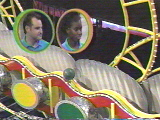
| Two players played. At the beginning, a ball was sent along a track which consisted of five hills and six valleys. The ball rolled back and forth among the hills until it settled into one of the valleys. The player who controlled that valley (each player had 3) went on to the next round, the other player took home $5000. | |
| In the second round, the ball was sent along the track again, with the valleys worth from $20,000 to $75,000. After that, the player could stop with the money he/she won or send the ball down the track one more time. For this third go-round, three valleys double the player's total, one valley added $10,000, and two valleys cut the player's winnings in half. The maximum possible prize is $150,000. | 
| |
Camelot's Riches (Played 2001-) | ||
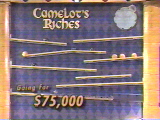
| One player took part. In the first round, the player set seven balls - four gold, two black - down a track of ramps. The balls could split up and collide until they reached the bottom of the track and crossed the finish line. If a black ball finished first, the player won $10,000; if a gold ball finished first, the player got $25,000.
For the second round, there were four gold and four black balls used. A black ball winning the race earned the player $10,000 more, while a gold ball won $75,000. After the third round, the player could either play the third round with three gold and four black balls, or with six gold and three black balls. The second set, however, would cost the player half his/her winnings at that point. A black ball coming in first added nothing, a gold ball finishing first added $75,000, while the gold balls came in first, second, and third, the player won the top prize - $250,000. | |
Twice as Grand Prix (Played 2001-)Each heat of the grand prix begins with six lottery players. The six players were grouped into three groups of two. For each group, the player reached into a pouch and drew one of three balls out. Two were green, one was red. If a green ball was drawn, the other player took a turn with one green and one red ball. If a red ball was drawn, that player was out and the other player advanced. The winning player then tried to draw the green ball again for a one-space head start in the race. | ||
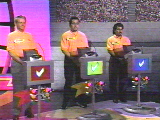
| When the race began, each player selected to go 1 or 3 spaces. The player who chose a different number than the other two got to move forward that number of spaces. After two rounds, the choice became 2 or 4 spaces. The first player to go 5 spaces and cross the finish line advanced to the final. The final was played between the three winners of each heat, and the eventual champion won the grand prize of $2000 a week for 20 years ($2,080,000 total). | 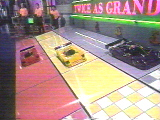
|
Easily one of the better lottery shows out there. The $2 million (and later $3M) top prize makes it watchable every week, and the variety of games makes it a lot of fun. There are some games, like Wizard of Odds and Dream Home, that I wouldn't mind seeing revived. The major problem with the show is the hosting jobs. You know the cast is lacking in ability when Pat Finn is considered the best host of the group! Well it's true: Larry Anderson reached a bit too far for the jokes occasionally, and Jack Gallagher had the personality of burnt toast. At least Pat brings some experience into the show. The set changes were OK, and the new California Gold qualifying game shows one thing - that Jonathon Goodson isn't messing around. Coming off of lottery hits like Flamingo Fortune and Illinois Instant Riche$, he certainly knows what he's doing. I expect a lot more of what he's done in the months and years to come on the show.
The Big Spin (Anderson's version)Gameplay: 3 pts.
|
The Big Spin (Gallagher's version)Gameplay: 2 pts.
|
The Big Spin (Finn's version)Gameplay: 3 pts.
|